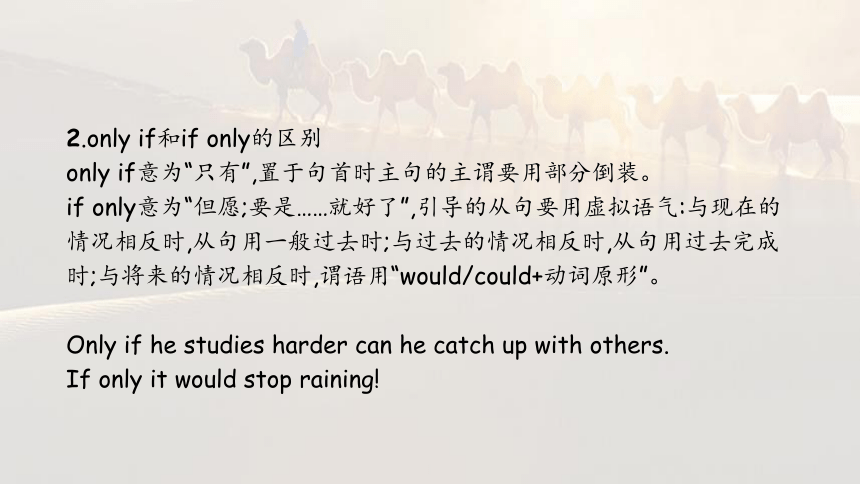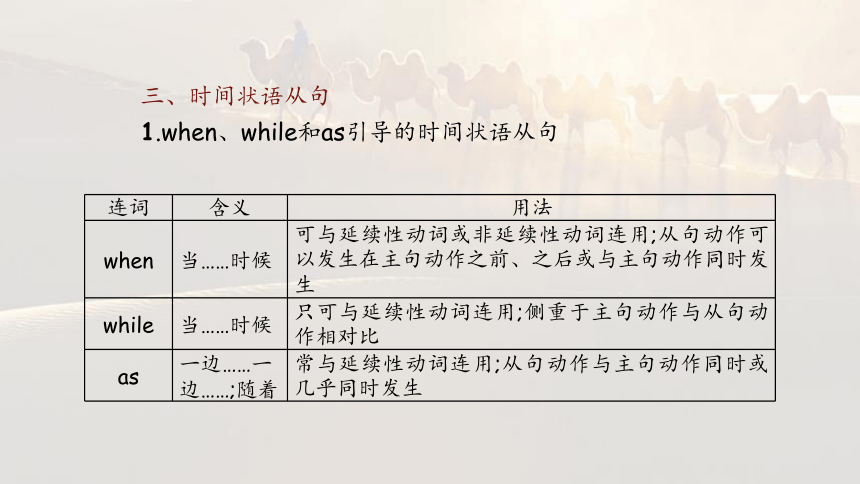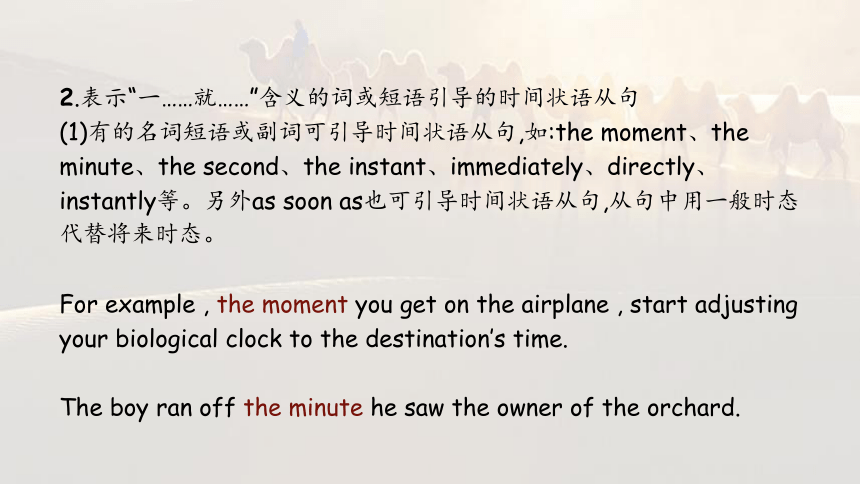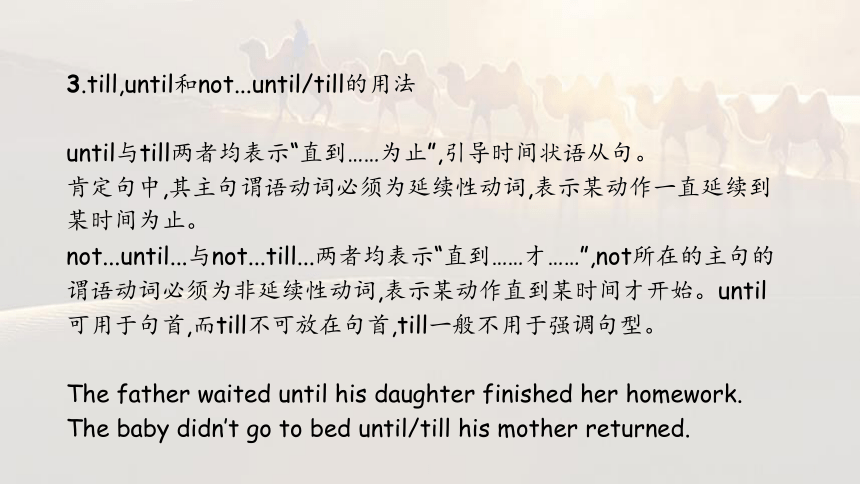外研版(2019)选择性必修 第四册Unit 3 The world meets China Using language &listening课件(共44张PPT)
文档属性
| 名称 | 外研版(2019)选择性必修 第四册Unit 3 The world meets China Using language &listening课件(共44张PPT) |  | |
| 格式 | pptx | ||
| 文件大小 | 3.1MB | ||
| 资源类型 | 教案 | ||
| 版本资源 | 外研版(2019) | ||
| 科目 | 英语 | ||
| 更新时间 | 2023-05-23 18:25:15 | ||
图片预览












文档简介
(共44张PPT)
Review: adverbial clauses
Using language
一、条件状语从句
1.引导条件状语从句的常见从属连词(短语)有:
if、unless、as/so long as、in case (万一)、once、on condition that、provided/providing (that)、supposing/suppose (that)、assuming that (假设)等。
You’ll fail the exam unless you study hard.
They agreed to lend us the car on condition that we returned it before the weekend.
My parents don’t mind what job I do as long as I am happy.
Adverbial clauses
2.only if和if only的区别
only if意为“只有”,置于句首时主句的主谓要用部分倒装。
if only意为“但愿;要是……就好了”,引导的从句要用虚拟语气:与现在的情况相反时,从句用一般过去时;与过去的情况相反时,从句用过去完成时;与将来的情况相反时,谓语用“would/could+动词原形”。
Only if he studies harder can he catch up with others.
If only it would stop raining!
二、让步状语从句
1.although、though、as与while引导的让步状语从句
Although he is considered a great writer , his works are not widely read.
Although this may sound like a simple task , great care is needed.
while也可以引导让步状语从句,但只能放在句首,意为“虽然;尽管”。
While he loves his students , he is very strict with them.
2.even if与even though引导的让步状语从句
even if与even though表示“即使,纵然”,引导让步状语从句时,可用虚拟语气,也可以用陈述语气。
I’ll do it , even if it takes me all afternoon.
Even if I were in your place , I wouldn’t take the job.
3.“疑问词+-ever”引导的让步状语从句
however、whatever、whoever、whenever等引导的让步状语从句相当于“no matter+疑问词”,意为“无论……”。
Wherever/No matter where you go , I would keep you company.
4.whether...or...引导的让步状语从句
Whether or not he will stay , I really don’t care.
三、时间状语从句
1.when、while和as引导的时间状语从句
连词 含义 用法
when 当……时候 可与延续性动词或非延续性动词连用;从句动作可以发生在主句动作之前、之后或与主句动作同时发生
while 当……时候 只可与延续性动词连用;侧重于主句动作与从句动作相对比
as 一边……一 边……;随着 常与延续性动词连用;从句动作与主句动作同时或几乎同时发生
Researchers in Britain found that when French music was played , sales of French wines went up.
While watching TV , children do not merely absorb words and images.
As he grew older , he became less active.
如果主句表示的是非延续性动作,而从句用延续性动词的进行时态表示在一段时间内正在进行的动作,则when、while与as可互换使用。
When/While/As I was walking down the street , I came across an old friend.
2.表示“一……就……”含义的词或短语引导的时间状语从句
(1)有的名词短语或副词可引导时间状语从句,如:the moment、the minute、the second、the instant、immediately、directly、instantly等。另外as soon as也可引导时间状语从句,从句中用一般时态代替将来时态。
For example , the moment you get on the airplane , start adjusting your biological clock to the destination’s time.
The boy ran off the minute he saw the owner of the orchard.
(2)在hardly/scarcely...when...和no sooner...than...结构中,主句用过去完成时,than或when所在的从句用一般过去时。
I had hardly told him the news when he stopped listening.
He had no sooner finished his speech than the students started cheering.
在hardly/scarcely...when...与no sooner...than...结构中,当hardly , scarcely或no sooner位于句首时,主句要用部分倒装。
They had hardly reached Edinburgh when they were ordered to return to London.
=Hardly had they reached Edinburgh when they were ordered to return to London.
3.till,until和not...until/till的用法
until与till两者均表示“直到……为止”,引导时间状语从句。
肯定句中,其主句谓语动词必须为延续性动词,表示某动作一直延续到某时间为止。
not...until...与not...till...两者均表示“直到……才……”,not所在的主句的谓语动词必须为非延续性动词,表示某动作直到某时间才开始。until可用于句首,而till不可放在句首,till一般不用于强调句型。
The father waited until his daughter finished her homework.
The baby didn’t go to bed until/till his mother returned.
4.after、before引导的时间状语从句
after表示“在……之后”;before表示“在……之前;还没来得及……就……”。
He changed his name after he left his hometown.
Before modern medicine changed the laws of nature , many children died of common childhood diseases.
5.since引导的时间状语从句
since意为“自从……以来”,从句的谓语动词一般是非延续性动词,主句的谓语动词一般是延续性动词。since从句的时态若是一般过去时,主句常用现在完成时或现在完成进行时。
They have been friends since they met for the first time in London.
It has been three years since the war ended.
6.其他常见名词短语引导的时间状语从句
every time每次、each time每次、any time任何时候、next time下次、the first/last time第一次/最后一次。
Every time I meet her I always forget her name.
The first time I met her , I thought her nice and honest.
四、原因状语从句
1.原因状语从句通常由because、since、as、now that等连词引导。
连词 区别 位置 内涵 能否回答why问句 能否被强调
because 主句前或后 直接原因 能 能
as(由于) 主句前或后 双方都知 道的原因 否 否
since/now that(既然) 主句前 Now that you’ve got a chance , you might as well make full use of it.
We had better hurry as it’s getting dark.
2.seeing that...(由于;鉴于)、considering that...(考虑到;鉴于)也可引导原因状语从句。
Seeing (that) the weather is bad , we’ll stay at home.
Considering (that) it is handmade , the price seems reasonable.
五、地点状语从句
地点状语从句可由where、wherever和everywhere引导。
You should make it a rule to leave things where you can find them again.
Everywhere they went , the distinguished guests were warmly welcomed.
where既可以引导定语从句,也可以引导地点状语从句。引导定语从句时,从句前应该有一个表示地点的名词作先行词,where可以变为“介词+关系代词”形式;而状语从句前则没有先行词。
Put the book at the place where you took it.(定语从句)
Put the book where you took it.(状语从句)
六、结果状语从句
引导结果状语从句的从属连词有:so that(因此)、so...that...(如此……以至于……)、such...that...(如此……以至于……)等。
so...that...与such...that...引导结果状语从句的结构形式为:
so+形容词/副词+that从句
so+形容词+a/an+可数名词单数+that从句
so+many/much/few/little(少)+名词+that从句
such+a/an+形容词+可数名词单数+that从句
such+形容词+可数名词复数/不可数名词+that从句
such+a lot of/lots of+名词+that从句
在so...that...和such...that...结构中,当“so+adj./adv.”或“such+n.”置于句首时,主句要部分倒装。
So fast did he run that I couldn’t catch him.
He is so experienced a worker that we all believe him.
=He is such an experienced worker that we all believe him.
七、目的状语从句
1.in order that与so that引导的目的状语
两个短语都意为“以便……;为了……”,其引导的状语从句中谓语应用“could/should/might/would+动词原形”。in order that比so that正式,其引导的状语从句可置于主句之前或之后;而so that引导的从句只能置于主句之后。
Speak louder so that/in order that the people in the hall can all hear you.
In order that we might get there on time , we should set out early.
2.for fear that(唯恐)与in case(以防)引导的目的状语从句
Leave your key with your neighbour in case you lock yourself out one day.
八.比较状语从句
比较状语从句一般位于句尾,常用
as...as、not as/so...as、比较级+than引导。
He is taller than any other student in our school.
John plays football as well as , if not better than , David.
九、方式状语从句
引导方式状语从句的从属连词有:as(正如,按照)、as if/though
as if或as though引导的从句与事实相反时,通常用虚拟语气:与现在事实相反时,从句用一般过去时;与过去事实相反时,从句谓语用“had+过去分词”;与将来事实相反时,从句谓语用“would/could/might+动词原形”。从句内容与事实相符或可能成为事实时,则用陈述句语气。
Please do as the teacher tells you to do.
They treat her as though she were their daughter.
Look at the clouds! It looks as if it is going to rain.
选词填空
as long as ,in case , so that , as though , even though , now that
1.Dad brought a notebook along to the beach, he was seized by sudden inspiration.
2.They may be able to help with childcare you can have a break.
3. my heart still beats , I will go on working for people.
in case
so that
As long as
_________I’m quite a reserved person , I like meeting people.
________we are all part of the global village , everyone becomes a neighbour.
6.It looks a compromise agreement has now been reached.
Even though
Now that
as though
1. b c d a
Look at the sentences from the reading passage and answer the questions.
Yo-Yo Ma is a French-born Chinese American cellist known for his musical talent. In 1998, Ma founded Silkroad, an organisation that explores musical traditions in countries 1__________________________________.
The fundamental purpose of Silkroad is to bring
people from across the globe together to play and
listen to music. Instruments and styles are blended
together to create music that is surprising, rich, and
completely original, 2________________________. What’s more, 3_____________________________, people can learn about the development of culture as a whole.
Complete the passage with the clauses in the box.
so that people can learn about different cultures
no matter what culture it comes from
as the traditional is mixed with the modern
The events that Silkroad organises are either performances, workshops, or mixed musical-artistic displays. It is so successful 4________________________________.
People meet as strangers, but they leave 5____________________, learning that different cultures have more in common than they imagined.
that over 15,000 people each year attend them
as if they are neighbours
Look at the picture and describe it using adverbial clauses where appropriate. You may use the information to help you.
Since HSR service started in China in 2008, it has undergone rapid growth. The experience of train travel suddenly became much more efficient and enjoyable because journeys were not only much faster but also more comfortable. China’s HSR had another technological leap when a major breakthrough was made in 2015, using independent R&D.
Travellers have become so accustomed to the incredible speed of HSR that many of us have already forgotten the old, slow trains of just a decade ago. Now, China cooperates with dozens of countries around the world in order to share its groundbreaking technology and develop HSR services overseas.
Zhang Qian , a diplomat, gave a reliable account of the lands of Central Asia for the Han court.
Read the timeline and find out what contributions each person made. Pay attention to the expressions in bold.
The second century BC:
Gan Ying , a military envoy, explored the Persian Gulf and became the first Chinese to get information on Europe.
The first century AD:
Xuanzang , a Chinese monk, scholar and traveller, translated volumes of scriptures from Sanskrit to Chinese and wrote The Great Tang Dynasty Record of the Western Regions, a description of the countries he visited on his travels.
The 7th century:
After six attempts, over a perod of twelve years, Chinese monk Jianzhen arrived in Japan , where he promoted exchange and understanding between China and Japan.
The 8th century:
Marco Polo’s travelled from Europe to Asia. The Travels of Marco Polo served to bring knowledge of Asia to the West.
The 13th century:
The 15th century:
Zheng He sailed to South-east Asia, South Asia, West Asia, and East Africa. Some of his voyages comprised as many as sixty treasure ships. These voyages led to legacy of cultural exchange between China and other countries.
Qian Zhongshu was a renowned literary scholar and writer. Born in 1910 in Jiangsu Province, he showed a strong interest in books at a very young age, earning him the name” Zhongshu”, which means fondness for books. His translations and writings 1_______________ of cultural exchange between China and the West that continues to this day.
In 1929, Qian was accepted into the Department of Foreign Languages at Tsinghua University. In 1935 , he went to Europe. He spent two years at Oxford University, where he studied and 2_________________English literature. He also studied in Paris for a year, before returning to China to teach. In addition to studying Western literature, he wrote a number of works on Chinese culture.
led to a legacy
got information on
Complete the passage with the correct form of the expressions in Activity 5.
Qian was an expert in both Chinese and Western languages and culture. This made him an excellent translator, who 3________________________________________ between Western and Chinese academics.
Selected and Annotated Song Dynasty Poetry was one of the many works he 4_________________ Chinese to English . One of Qian`s great achievements was to produce comparative studies of classical Chinese texts, which made these works more accessible to Western readers. These book helped 5__________________ Chinese literature to the West.
promoted exchange and understanding
translated from
bring knowledge of
The Confucius Institute is a non-profit educational organisation run by the Chinese Ministry of Education, aiming to promote Chinese language and culture abroad and to encourage cultural exchange. The first institute opened in 2004, and today there are over 500 institutes around the world. In addition to Chinese language courses, the institutes also support activities, such as art exhibitions, concerts and film festivals.
Did You Know
1, 4, 5
Liang Ran spent 1_____________ abroad working as a teacher at 2____________________________. He said it was a difficult decision, because it would mean 3_________________ . Finally, he decided to go as he wanted to help foreigners learn Chinese and learn about China. He also wanted to 4___________________________.
_____________________At first, Liang was surprised at 5____________________________ , as they were quite varied. They were all interested in Chinese culture, however. One challenge they met was that they 6_________________________________, so Liang had to give them a lot of support.
a whole year
the Confucius Institute in New York
delaying his studies
experience life abroad and
learn about Western culture
the different ages of the students
had some difficulty with Chinese characters
Listen again and complete the passage.
Liang`s most memorable experience was at the end of the year when students learnt about traditional Chinese dancing and 7_____________________. Liang said their 8__________________ was amazing.
Working there made Liang a better person. Through teaching Chinese, he 9____________________________, and through interacting with students, he 10____________________.
Chinese costumes
enthusiasm
became even more proud of China
learnt more about the world
Now talk about the role the Confucius Institute plays in promoting intercultural exchange.
Giving reasons
Drawing conclusions
The reason why ...
is that ...
That was due to...
On the whole, ...
To sum up, ...
In short, ...
Complete the boxes with the expressions from the conversation.
Thank you !
Review: adverbial clauses
Using language
一、条件状语从句
1.引导条件状语从句的常见从属连词(短语)有:
if、unless、as/so long as、in case (万一)、once、on condition that、provided/providing (that)、supposing/suppose (that)、assuming that (假设)等。
You’ll fail the exam unless you study hard.
They agreed to lend us the car on condition that we returned it before the weekend.
My parents don’t mind what job I do as long as I am happy.
Adverbial clauses
2.only if和if only的区别
only if意为“只有”,置于句首时主句的主谓要用部分倒装。
if only意为“但愿;要是……就好了”,引导的从句要用虚拟语气:与现在的情况相反时,从句用一般过去时;与过去的情况相反时,从句用过去完成时;与将来的情况相反时,谓语用“would/could+动词原形”。
Only if he studies harder can he catch up with others.
If only it would stop raining!
二、让步状语从句
1.although、though、as与while引导的让步状语从句
Although he is considered a great writer , his works are not widely read.
Although this may sound like a simple task , great care is needed.
while也可以引导让步状语从句,但只能放在句首,意为“虽然;尽管”。
While he loves his students , he is very strict with them.
2.even if与even though引导的让步状语从句
even if与even though表示“即使,纵然”,引导让步状语从句时,可用虚拟语气,也可以用陈述语气。
I’ll do it , even if it takes me all afternoon.
Even if I were in your place , I wouldn’t take the job.
3.“疑问词+-ever”引导的让步状语从句
however、whatever、whoever、whenever等引导的让步状语从句相当于“no matter+疑问词”,意为“无论……”。
Wherever/No matter where you go , I would keep you company.
4.whether...or...引导的让步状语从句
Whether or not he will stay , I really don’t care.
三、时间状语从句
1.when、while和as引导的时间状语从句
连词 含义 用法
when 当……时候 可与延续性动词或非延续性动词连用;从句动作可以发生在主句动作之前、之后或与主句动作同时发生
while 当……时候 只可与延续性动词连用;侧重于主句动作与从句动作相对比
as 一边……一 边……;随着 常与延续性动词连用;从句动作与主句动作同时或几乎同时发生
Researchers in Britain found that when French music was played , sales of French wines went up.
While watching TV , children do not merely absorb words and images.
As he grew older , he became less active.
如果主句表示的是非延续性动作,而从句用延续性动词的进行时态表示在一段时间内正在进行的动作,则when、while与as可互换使用。
When/While/As I was walking down the street , I came across an old friend.
2.表示“一……就……”含义的词或短语引导的时间状语从句
(1)有的名词短语或副词可引导时间状语从句,如:the moment、the minute、the second、the instant、immediately、directly、instantly等。另外as soon as也可引导时间状语从句,从句中用一般时态代替将来时态。
For example , the moment you get on the airplane , start adjusting your biological clock to the destination’s time.
The boy ran off the minute he saw the owner of the orchard.
(2)在hardly/scarcely...when...和no sooner...than...结构中,主句用过去完成时,than或when所在的从句用一般过去时。
I had hardly told him the news when he stopped listening.
He had no sooner finished his speech than the students started cheering.
在hardly/scarcely...when...与no sooner...than...结构中,当hardly , scarcely或no sooner位于句首时,主句要用部分倒装。
They had hardly reached Edinburgh when they were ordered to return to London.
=Hardly had they reached Edinburgh when they were ordered to return to London.
3.till,until和not...until/till的用法
until与till两者均表示“直到……为止”,引导时间状语从句。
肯定句中,其主句谓语动词必须为延续性动词,表示某动作一直延续到某时间为止。
not...until...与not...till...两者均表示“直到……才……”,not所在的主句的谓语动词必须为非延续性动词,表示某动作直到某时间才开始。until可用于句首,而till不可放在句首,till一般不用于强调句型。
The father waited until his daughter finished her homework.
The baby didn’t go to bed until/till his mother returned.
4.after、before引导的时间状语从句
after表示“在……之后”;before表示“在……之前;还没来得及……就……”。
He changed his name after he left his hometown.
Before modern medicine changed the laws of nature , many children died of common childhood diseases.
5.since引导的时间状语从句
since意为“自从……以来”,从句的谓语动词一般是非延续性动词,主句的谓语动词一般是延续性动词。since从句的时态若是一般过去时,主句常用现在完成时或现在完成进行时。
They have been friends since they met for the first time in London.
It has been three years since the war ended.
6.其他常见名词短语引导的时间状语从句
every time每次、each time每次、any time任何时候、next time下次、the first/last time第一次/最后一次。
Every time I meet her I always forget her name.
The first time I met her , I thought her nice and honest.
四、原因状语从句
1.原因状语从句通常由because、since、as、now that等连词引导。
连词 区别 位置 内涵 能否回答why问句 能否被强调
because 主句前或后 直接原因 能 能
as(由于) 主句前或后 双方都知 道的原因 否 否
since/now that(既然) 主句前 Now that you’ve got a chance , you might as well make full use of it.
We had better hurry as it’s getting dark.
2.seeing that...(由于;鉴于)、considering that...(考虑到;鉴于)也可引导原因状语从句。
Seeing (that) the weather is bad , we’ll stay at home.
Considering (that) it is handmade , the price seems reasonable.
五、地点状语从句
地点状语从句可由where、wherever和everywhere引导。
You should make it a rule to leave things where you can find them again.
Everywhere they went , the distinguished guests were warmly welcomed.
where既可以引导定语从句,也可以引导地点状语从句。引导定语从句时,从句前应该有一个表示地点的名词作先行词,where可以变为“介词+关系代词”形式;而状语从句前则没有先行词。
Put the book at the place where you took it.(定语从句)
Put the book where you took it.(状语从句)
六、结果状语从句
引导结果状语从句的从属连词有:so that(因此)、so...that...(如此……以至于……)、such...that...(如此……以至于……)等。
so...that...与such...that...引导结果状语从句的结构形式为:
so+形容词/副词+that从句
so+形容词+a/an+可数名词单数+that从句
so+many/much/few/little(少)+名词+that从句
such+a/an+形容词+可数名词单数+that从句
such+形容词+可数名词复数/不可数名词+that从句
such+a lot of/lots of+名词+that从句
在so...that...和such...that...结构中,当“so+adj./adv.”或“such+n.”置于句首时,主句要部分倒装。
So fast did he run that I couldn’t catch him.
He is so experienced a worker that we all believe him.
=He is such an experienced worker that we all believe him.
七、目的状语从句
1.in order that与so that引导的目的状语
两个短语都意为“以便……;为了……”,其引导的状语从句中谓语应用“could/should/might/would+动词原形”。in order that比so that正式,其引导的状语从句可置于主句之前或之后;而so that引导的从句只能置于主句之后。
Speak louder so that/in order that the people in the hall can all hear you.
In order that we might get there on time , we should set out early.
2.for fear that(唯恐)与in case(以防)引导的目的状语从句
Leave your key with your neighbour in case you lock yourself out one day.
八.比较状语从句
比较状语从句一般位于句尾,常用
as...as、not as/so...as、比较级+than引导。
He is taller than any other student in our school.
John plays football as well as , if not better than , David.
九、方式状语从句
引导方式状语从句的从属连词有:as(正如,按照)、as if/though
as if或as though引导的从句与事实相反时,通常用虚拟语气:与现在事实相反时,从句用一般过去时;与过去事实相反时,从句谓语用“had+过去分词”;与将来事实相反时,从句谓语用“would/could/might+动词原形”。从句内容与事实相符或可能成为事实时,则用陈述句语气。
Please do as the teacher tells you to do.
They treat her as though she were their daughter.
Look at the clouds! It looks as if it is going to rain.
选词填空
as long as ,in case , so that , as though , even though , now that
1.Dad brought a notebook along to the beach, he was seized by sudden inspiration.
2.They may be able to help with childcare you can have a break.
3. my heart still beats , I will go on working for people.
in case
so that
As long as
_________I’m quite a reserved person , I like meeting people.
________we are all part of the global village , everyone becomes a neighbour.
6.It looks a compromise agreement has now been reached.
Even though
Now that
as though
1. b c d a
Look at the sentences from the reading passage and answer the questions.
Yo-Yo Ma is a French-born Chinese American cellist known for his musical talent. In 1998, Ma founded Silkroad, an organisation that explores musical traditions in countries 1__________________________________.
The fundamental purpose of Silkroad is to bring
people from across the globe together to play and
listen to music. Instruments and styles are blended
together to create music that is surprising, rich, and
completely original, 2________________________. What’s more, 3_____________________________, people can learn about the development of culture as a whole.
Complete the passage with the clauses in the box.
so that people can learn about different cultures
no matter what culture it comes from
as the traditional is mixed with the modern
The events that Silkroad organises are either performances, workshops, or mixed musical-artistic displays. It is so successful 4________________________________.
People meet as strangers, but they leave 5____________________, learning that different cultures have more in common than they imagined.
that over 15,000 people each year attend them
as if they are neighbours
Look at the picture and describe it using adverbial clauses where appropriate. You may use the information to help you.
Since HSR service started in China in 2008, it has undergone rapid growth. The experience of train travel suddenly became much more efficient and enjoyable because journeys were not only much faster but also more comfortable. China’s HSR had another technological leap when a major breakthrough was made in 2015, using independent R&D.
Travellers have become so accustomed to the incredible speed of HSR that many of us have already forgotten the old, slow trains of just a decade ago. Now, China cooperates with dozens of countries around the world in order to share its groundbreaking technology and develop HSR services overseas.
Zhang Qian , a diplomat, gave a reliable account of the lands of Central Asia for the Han court.
Read the timeline and find out what contributions each person made. Pay attention to the expressions in bold.
The second century BC:
Gan Ying , a military envoy, explored the Persian Gulf and became the first Chinese to get information on Europe.
The first century AD:
Xuanzang , a Chinese monk, scholar and traveller, translated volumes of scriptures from Sanskrit to Chinese and wrote The Great Tang Dynasty Record of the Western Regions, a description of the countries he visited on his travels.
The 7th century:
After six attempts, over a perod of twelve years, Chinese monk Jianzhen arrived in Japan , where he promoted exchange and understanding between China and Japan.
The 8th century:
Marco Polo’s travelled from Europe to Asia. The Travels of Marco Polo served to bring knowledge of Asia to the West.
The 13th century:
The 15th century:
Zheng He sailed to South-east Asia, South Asia, West Asia, and East Africa. Some of his voyages comprised as many as sixty treasure ships. These voyages led to legacy of cultural exchange between China and other countries.
Qian Zhongshu was a renowned literary scholar and writer. Born in 1910 in Jiangsu Province, he showed a strong interest in books at a very young age, earning him the name” Zhongshu”, which means fondness for books. His translations and writings 1_______________ of cultural exchange between China and the West that continues to this day.
In 1929, Qian was accepted into the Department of Foreign Languages at Tsinghua University. In 1935 , he went to Europe. He spent two years at Oxford University, where he studied and 2_________________English literature. He also studied in Paris for a year, before returning to China to teach. In addition to studying Western literature, he wrote a number of works on Chinese culture.
led to a legacy
got information on
Complete the passage with the correct form of the expressions in Activity 5.
Qian was an expert in both Chinese and Western languages and culture. This made him an excellent translator, who 3________________________________________ between Western and Chinese academics.
Selected and Annotated Song Dynasty Poetry was one of the many works he 4_________________ Chinese to English . One of Qian`s great achievements was to produce comparative studies of classical Chinese texts, which made these works more accessible to Western readers. These book helped 5__________________ Chinese literature to the West.
promoted exchange and understanding
translated from
bring knowledge of
The Confucius Institute is a non-profit educational organisation run by the Chinese Ministry of Education, aiming to promote Chinese language and culture abroad and to encourage cultural exchange. The first institute opened in 2004, and today there are over 500 institutes around the world. In addition to Chinese language courses, the institutes also support activities, such as art exhibitions, concerts and film festivals.
Did You Know
1, 4, 5
Liang Ran spent 1_____________ abroad working as a teacher at 2____________________________. He said it was a difficult decision, because it would mean 3_________________ . Finally, he decided to go as he wanted to help foreigners learn Chinese and learn about China. He also wanted to 4___________________________.
_____________________At first, Liang was surprised at 5____________________________ , as they were quite varied. They were all interested in Chinese culture, however. One challenge they met was that they 6_________________________________, so Liang had to give them a lot of support.
a whole year
the Confucius Institute in New York
delaying his studies
experience life abroad and
learn about Western culture
the different ages of the students
had some difficulty with Chinese characters
Listen again and complete the passage.
Liang`s most memorable experience was at the end of the year when students learnt about traditional Chinese dancing and 7_____________________. Liang said their 8__________________ was amazing.
Working there made Liang a better person. Through teaching Chinese, he 9____________________________, and through interacting with students, he 10____________________.
Chinese costumes
enthusiasm
became even more proud of China
learnt more about the world
Now talk about the role the Confucius Institute plays in promoting intercultural exchange.
Giving reasons
Drawing conclusions
The reason why ...
is that ...
That was due to...
On the whole, ...
To sum up, ...
In short, ...
Complete the boxes with the expressions from the conversation.
Thank you !
